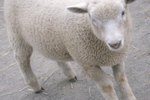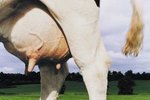
Foot rot is a serious hoof condition that can cause cattle to experience pain and suffering. An article on the Virginia Cooperative Extension Service website estimates that foot rot is responsible for 75 percent of lameness problems experienced by commercial cattle. If you do not treat foot rot quickly and appropriately, your bovines may suffer unnecessarily from the painful condition.
Understanding Foot Rot
Interdigital Necrobacilosis is the true medical name for the foot rot cattle experience. Foot rot is a bacterial infection that occurs in the interdigital area of the foot -- the area between the cow's two toes. Foot rot is most often caused by the Fusobacterium necrophorum bacteria, according to the Virginia extension website article, authored by three veterinarians. These bacteria are present in the manure, rumen and hooves of cows with foot rot and of those who are healthy. Foot rot occurs when an injury is present on the foot and the bacteria are able to enter through the damaged tissue and cause infection.
Spread of Foot Rot
Foot rot can spread within a herd due to its presence in manure. When a cow with an injury steps in infected manure, the cow will pick up the bacteria and, in most cases, develop foot rot as a result. Swampy, flooded or muddy ground seems to aid in the spread of the disease, especially in areas where a lot of cows travel through on a regular basis.
Identifying Foot Rot
The most telltale sign of foot rot is lameness. Cows are more likely to develop foot rot in their hind legs than they are in their front legs. Cows can develop foot rot in multiple legs. If you suspect your cow has foot rot, you should examine the area between the toes for sensitivity to touch or pressure, decaying tissue, visibly swollen, infected tissue and a foul odor coming from the foot.
Treatment
Your large-animal vet can provide antibiotics to treat foot rot. Most veterinarians choose to inject the antibiotic under the skin rather than apply it to the hoof itself. A vaccine to protect against foot rot is available. Vaccinating high-risk cattle against foot rot can protect them from developing this painful infection.
References
Photo Credits
-
John Foxx/Stockbyte/Getty Images
Writer Bio
Jen Davis has been writing since 2004. She has served as a newspaper reporter and her freelance articles have appeared in magazines such as "Horses Incorporated," "The Paisley Pony" and "Alabama Living." Davis earned her Bachelor of Arts in communication with a concentration in journalism from Berry College in Rome, Ga.




